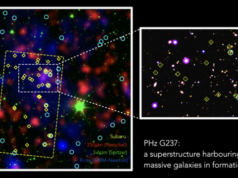The pulsar pictured here, which resides in the Messier 82 galaxy 12 million light-years away, sends out X-ray beams that pass Earth every 1.37 seconds. Scientists studying this object with NuSTAR originally thought it was a massive black hole, but its X-ray pulse revealed its true pulsar identity. Credit: NASA/JPL-Caltech
A new discovery has upended the widely held view that all pulsars are orderly ticking clocks of the universe. A survey done at the Arecibo Observatory in Puerto Rico has fortuitously discovered two extremely strange pulsars that undergo a “cosmic vanishing act.” Sometimes they are there, and then for very long periods of time, they are not.
Recognizing the existence of this strange behavior was fortuitous in itself. It took great patience on the part of a team of radio astronomers at Jodrell Bank in the UK led by Professor Andrew Lyne of the University of Manchester to confirm the existence of these mostly invisible pulsars.
Pulsars are rapidly rotating, highly magnetized neutron stars. They are about 20 miles across with masses of about 500,000 Earths. The rotation sends charged particles streaming out from the magnetic poles, causing beams of radio waves to sweep around the sky—like the light beams from a lighthouse. This results in pulses, which can be received by terrestrial radio telescopes.
Intermittent pulsars are a rarely observed population of pulsars, which have two states—one when they pulse like normal pulsars (the ON state), and another when they mysteriously fail to work, producing no radio waves at all (the OFF state). “They switch instantaneously between the states,” notes Lyne. “They’re ON and then they’re gone, disappearing without any apparent warning.”
Find your dream job in the space industry. Check our Space Job Board »
A 34-member pulsar study team, including Dr. Andrew Seymour, a USRA postdoc at Arecibo, used the 7-beam receiver to conduct routine pulsar searches in what they call the PALFA (Pulsar Arecibo L-Band Feed Array) Survey. The two recently discovered intermittent pulsars spend most of their time in the OFF state. Three other similar pulsars are also known, but they are mostly ON.
In September 2012, one of these new objects was discovered to be emitting very bright pulses, and it was labeled PSR J1929+1357. Of 169 new pulsars, follow-up observations of half of those had been initiated at Jodrell Bank and this candidate was confirmed as a pulsar in February 2013 using the 250-ft Lovell Telescope at the second attempt. “During the next 9 months it was observed no fewer than 650 times—100 hours,” said Professor Benjamin Stappers of the Jodrell Bank Center for Astrophysics and a co-author on the publication. “It was ON on only 5 occasions—just 0.8% of the time.”
The most important implication of this discovery is that there must exist an extremely large number these vanishing act pulsars. The PALFA survey, which is aimed at a section of the Milky Way visible to the Arecibo dish, only covers each position in the survey once. It probably passed over 130 similar pulsars, but this was the only one that was ON at the time of observation. Furthermore, if it were not for the early signals at Jodrell Bank, this pulsar could easily have been discarded as a false detection, likely arising from radio-frequency interference. The PALFA team estimates that there are about 3,000 such intermittent pulsars in the survey area, far greater than the population of normal pulsars.
“These disappearing pulsars may far outnumber normal pulsars,” said Dr. Victoria Kaspi of McGill University in Canada and the principal investigator on the PALFA project. “In fact, they may redefine what we think of as normal.”
Why this odd behavior? After all, since the original pulsar discovery in 1967, they have been referred to as marvelously accurate cosmic clocks that tick steadily for millions years with a cadence that surpasses the ticking of our best laboratory clocks. But these long-term intermittent pulsars are mostly invisible, which is about as useful as having the clock on the wall that is hidden behind a curtain for most of the time.
“The explanation of the ON-OFF behavior remains a puzzle,” says Seymour. “It indicates that the pulsar environment is changing, but just what those changes entail is open to debate.”
Recent observations of these odd pulsars suggest that their rotational slow-down rate when OFF is only 80 percent of the rate when ON. A property of “normal” pulsars is their pulse rate slows very gradually over time. The PALFA team suspects that the stream of charged particles, which drive the radio beams emanating from the pulsar, also causes the pulsar to spin down more rapidly. When OFF, this particle stream fails for some reason and the spin down rate is reduced. But as Seymour notes, there is as yet no agreement in the pulsar community as to the ON-OFF mechanism.
The changing spin rate is inferred by calculating how many beats were missed during the pulsar’s invisible phases.
PALFA surveys are ongoing, and no one can predict if and when more examples of this fascinating new phenomenon will be found. Catching another intermittent pulsar in its ON mode is up to chance. Is there another candidate out there ready to reveal its secrets, or will it forever lurk hidden in the dark unknowns of space?
Lyne hopes that follow-up measurements of PSR J1929+1357 will provide a rare insight into the physics of the pulsar emission mechanism and the changing spin-down phenomenon.
Source: USRA
Journal Reference:
A. G. Lyne, B. W. Stappers, P. C. C. Freire, J. W. T. Hessels, V. M. Kaspi, B. Allen, S. Bogdanov, A. Brazier, F. Camilo, F. Cardoso, S. Chatterjee, J. M. Cordes, F. Crawford, J. S. Deneva, R. D. Ferdman, F. A. Jenet, B. Knispel, P. Lazarus, J. van Leeuwen, R. Lynch, E. Madsen, M. A. McLaughlin, E. Parent, C. Patel, S. M. Ransom, P. Scholz, A. Seymour, X. Siemens, L. G. Spitler, I. H. Stairs, K. Stovall, J. Swiggum, R. S. Wharton, W. W. Zhu. Two long-term intermittent pulsars discovered in the PALFA Survey. arxiv.org/abs/1608.09008











